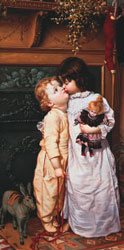|
Why do we kiss under the mistletoe?Mistletoe has long been ascribed with mystical powers in Ireland, far stronger than just a spark of romance after a brief kiss.
Since Victorian times, it has been a cherished Christmas decoration. Kissing under the mistletoe is as much an Irish Christmas tradition as it is anywhere else. But for centuries before that custom came into practice, this custom was actually banned in Christian Ireland...anything held so dear by the "pagans" (Druids) was thought to be evil. It is actually a parasitic plant, found high in the trees. It doesn't take root in the ground, but in the branches of tree itself. Although it gets all its nutrients by taking them from the tree, its presence keeps the tree green throughout the winter. Holly, mistletoe, pine and fir trees were quite logically celebrated in the winter because they bring color to a colorless landscape...and they remind us that even though the daylight is scarce and everywhere it is cold and gray, springtime is just around the corner. Because of the ancient writings of Pliny the Elder we know of the ancient rituals in which Druid priests celebrated the mistletoe plant. After the Winter Solstice, the Druid priests gathered the mistletoe in a special ceremony that lasted five days after the new moon. They would venture into the forests with a golden sickle to cut the mistletoe down from the Oak trees (which they also held in sacred honor). The priests separated the branches and distributed sprigs of mistletoe among the people to protect them from evil. The Druids believed plants and trees all had a soul. So with mistletoe taking root in the boughs of the trees and keeping them green through the long, cold winter, the Druids believed the mistletoe was holding the soul of the tree. Ancient Celts also believed the mistletoe plant held miraculous healing powers. In fact, the word "mistletoe" in Celtic means "All-Heal". The Celts took it on further and came to believe the mistletoe have strongly benevolent powers. They believed it could heal the sick, serve as an antidote for poison, make any living creature more fertile, ward off evil, and bring good luck and many blessings.
So how did the custom of kissing
|
Click here to learn about the symbolism of the Christmas Holly
Click here to learn about the symbolism of the Candle in the Window
Click here to return to an Irish Christmas on Fantasy-Ireland.com
Home | Blog | Search | Site Map | Link to Me | Request a Link
About Me | Resources | Submit Your Article | Contact Me | Privacy Policy





